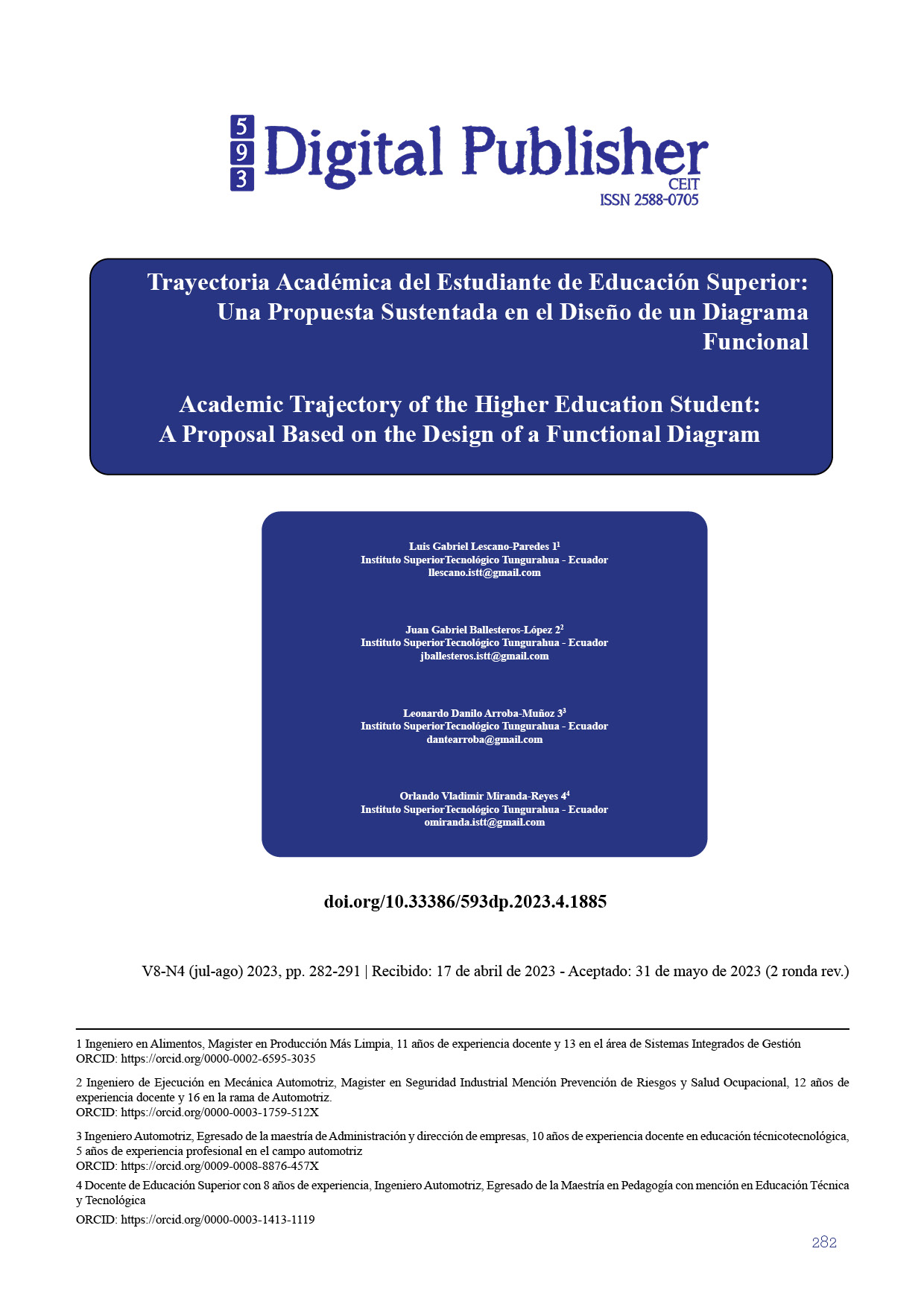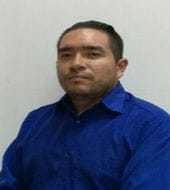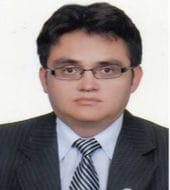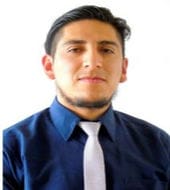Academic Trajectory of the Higher Education Student A Proposal Based on the Design of a Functional Diagram
Main Article Content
Abstract
The objective of the work was to create a functional diagram for the academic career of students at technological institutes of Ecuador. The method used was based on the Deming cycle, which is based on the processes of planning, doing, reviewing, and acting. The participants of the study were students of a higher education institution in Ecuador. In this analysis, the process is considered as a series of successive logical operations that can justify the execution of an objective established by a vertical analysis. In the same way, through a horizontal study, it is possible to develop a procedure that considers the resources that move within the process. For the present research, there are three possible scenarios: the real, the ideal and the functional, which consist of the use of typical symbols of a process with formats to develop flowcharts. Among these diagrams, we selected processes, decision-making processes, sub-processes, start/finish processes, and documents to design the total number of hours that students must stay in the facility. This resulted in an estimated functional time of 5,541 hours, considering that there are modalities such as dissertations and complex exams within the completion processes. In addition, there are also extension times to complete the degree.
Downloads
Article Details

This work is licensed under a Creative Commons Attribution-NonCommercial-ShareAlike 4.0 International License.
1. Derechos de autor
Las obras que se publican en 593 Digital Publisher CEIT están sujetas a los siguientes términos:
1.1. 593 Digital Publisher CEIT, conserva los derechos patrimoniales (copyright) de las obras publicadas, favorece y permite la reutilización de las mismas bajo la licencia Licencia Creative Commons 4.0 de Reconocimiento-NoComercial-CompartirIgual 4.0, por lo cual se pueden copiar, usar, difundir, transmitir y exponer públicamente, siempre que:
1.1.a. Se cite la autoría y fuente original de su publicación (revista, editorial, URL).
1.1.b. No se usen para fines comerciales u onerosos.
1.1.c. Se mencione la existencia y especificaciones de esta licencia de uso.
References
ANALITICA. (2011). Manual de diagramación de procesos bajo estándar BPMN. Sistema de Gestión por
Procesos.
Arguelles, A. (1996). Reseña: Competencia laboral y educación basada en normas de competencia. Limusa. Mexico. Retrieved from https://revistas.ibero.mx/didac/uploads/volumenes/16/pdf/46.pdf
Audretsch, D. B. (2014). From the entrepreneurial university to the university for the entrepreneurial society. Estados Unidos: Technology Transfer.
Barceló, A. A. (2012). Introducción a la Lógica Intensional, Lógica Temporal Proposicional, Tablas de verdad.
Beltran Jaramillo, J. M. (1997). Indicadores de Gestión. Bogota, Colombia: 3R Editores
Bolívar, A. (2011). Aprender a liderar lideres. EDUCAR.
Bourke, A. (2013). Civil Society and the Global Agenda of Community.
Bravo, J. (2011). Gestión de procesos. Santiago de Chile.
Casamayor, A. Y. R., & Fajardo, M. V. (2015). Comunicación Universitaria. Pautas para su gestión desde el contexto de la Educación Superior cubana. Razón y Palabra, (92), 1-29.
Consejo de Educación Superior. (2020). Reglamento de Régimen Académico. RPC-SO-16-
No.331-2020. Quito – Ecuador.
Cuevas Villegas, C. F., & Moreno Lasprilla, F. H. (2003). Estudio De Factibilidad Para La Creación De Una Empresa De Servicios De Ingeniería. Retrieved from www.scielo.org.co/scielo.php?script=sci_arttext&pid=S0123-59232003000300002
Cruz, C. L. R. (n.d.). Meta-análisis sobre la determinación de la estructura de capital en empresas colombianas. Bdigital.unal.edu.co. Retrieved from http://www.bdigital.unal.edu.co/48546/
Estrada, E. R. R. (2016). El costo promedio ponderado del capital y el endeudamiento en el comportamiento de los índices de rentabilidad de las empresas pequeñas y medianas del sector …. repositorio.puce.edu.ec. Retrieved from http://repositorio.puce.edu.ec/handle/22000/13445
Gallardo, J. (2008). Lógica Matemática. Retrieved from http://logicamates.blogspot.com/2015/05/tabla-de-la-verdad.html
Gillet, F. (2014). La caja de herramientas: Control de calidad.
INEC. (2012). Clasificación Nacional de Actividades Económicas (CIIU Rev. 4.0). Unidad de Análisis de Síntesis. Retrieved from http://www.inec.gob.ec/estadisticas/SIN/metodologias/CIIU 4.0.pdf
Instituto Nacional de Estadística y Censos . (2012). Resultados del censo 2010 de población y vivienda en el Ecuador. Ambato: Dirección Regional del Centro.
Ishikawa, K. (2002). ¿Qué es control total de calidad? . Bogota, Colombia: Educactiva
Hileman, M. D. R. F., Corengia, Á., & Durand, J. (2014). Deserción y retención universitaria: una discusión bibliográfica. Pensando Psicología, 10(17), 85-96.
Martínez de Carrasquero, C., Mavárez, R. J., & Rojas, L. A. (2008). La responsabilidad social universitaria como estrategia de vinculación con su entorno social. Caracas.
Meléndez, S. G. (2008). La planificación curricular en el aula. Un modelo de enseñanza por competencia. Laurus.
Ministerio de Educación, N. d. (2013). Lineamientos Política de Educación Superior Inclusiva. Bogotá - Colombia.
Organización Internacional de Normalización. (2015). Sistemas de Gestión de la Calidad. ISO 9001:2015. Geneva – Suiza.
Páez, A. y Fuenmayor, J. (2005). Paradigmas sobre Gestión Comunicacional en el Ámbito Universitario. Revista Razón y palabra, Febrero-Marzo, No. 43. Recuperado de: http://www.razonypalabra.org.mx/anteriores/n43/paezfuenmayor.html
Pérez, G. G. (2015). Liderazgo transformacional en los docentes universitarios desde la perpectiva estudiantil. Medellin- Colombia: Saber Ciencia y Libertad.
Prince, Á. C. (2020). Política Pública de Educación Superior para la incorporación de mujeres. Las Américas.
Raffino, M. E. (2018, noviembre 20). Concepto.de. Retrieved from Concepto.de: https://concepto.de/circuito-en-serie/
SENESCYT. (15 de ENERO de 2023). Estadísticas de Educación Superior, Ciencia, Tecnología e Innovación. Obtenido de https://siau.senescyt.gob.ec/estadisticas-de-educacion-superior-ciencia-tecnologia-e-innovacion
Soleimani, M., Tabriz, A. A., & Shavarini, S. K. (2016). Developing a Model to Explain the Process of Technology.
Vinueza, W. Z., Castillo, J. R. S., Salazar, J. G., & Montenegro, F. M. (2017). Análisis de los tiempos de titulación de la carrera de Ingeniería en Electrónica, Telecomunicaciones y Redes. Revista Publicando, 4(10 - 1), 231-242.





